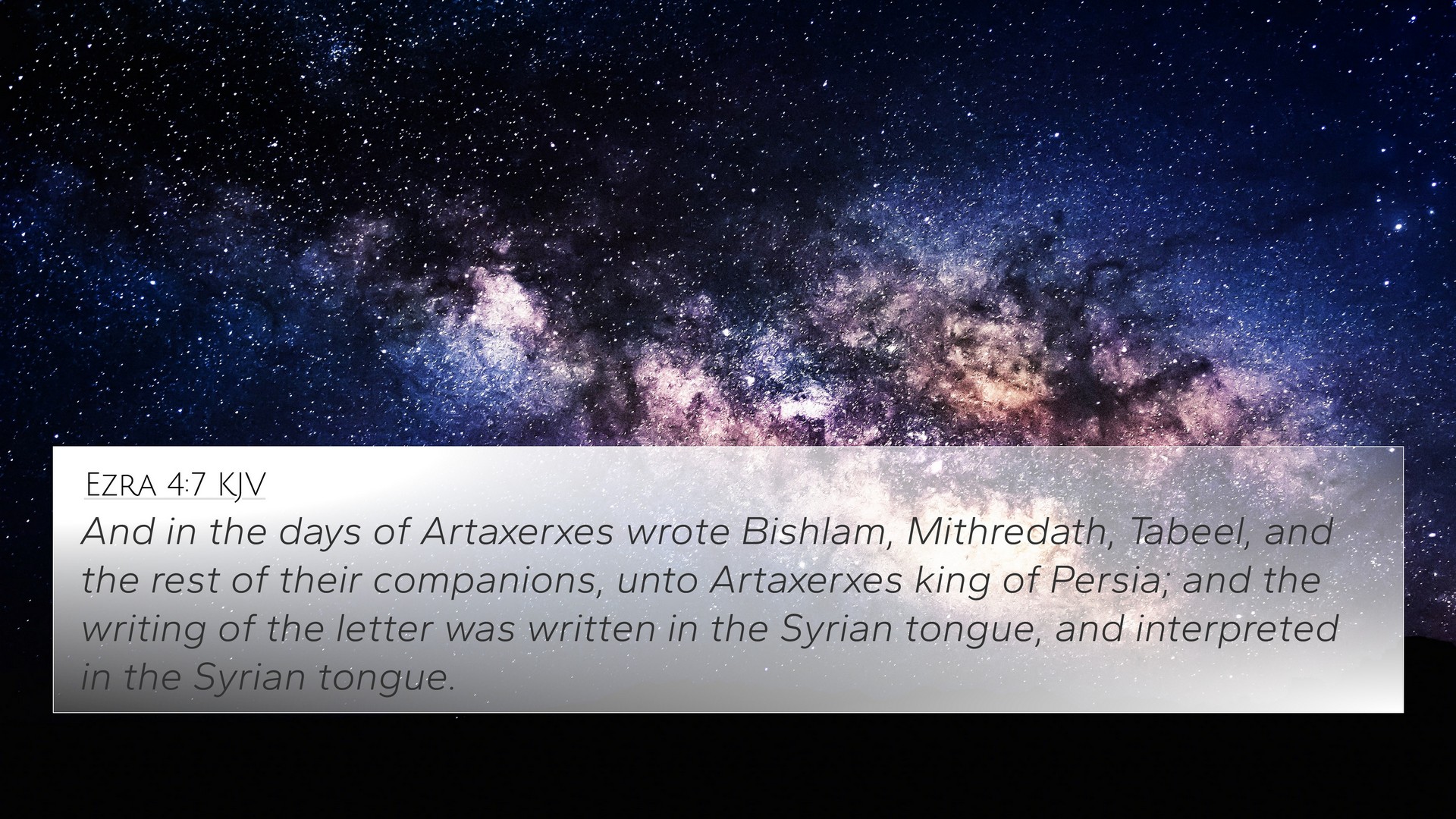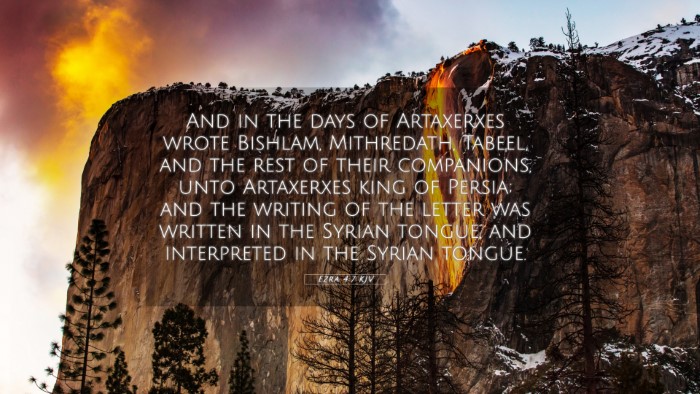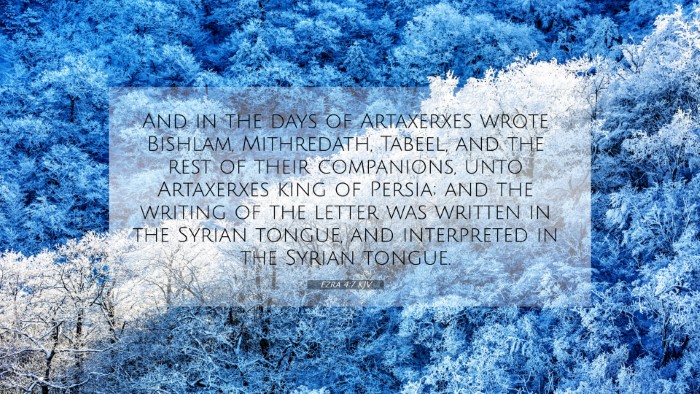Old Testament
Genesis Exodus Leviticus Numbers Deuteronomy Joshua Judges Ruth 1 Samuel 2 Samuel 1 Kings 2 Kings 1 Chronicles 2 Chronicles Ezra Nehemiah Esther Job Psalms Proverbs Ecclesiastes Song of Solomon Isaiah Jeremiah Lamentations Ezekiel Daniel Hosea Joel Amos Obadiah Jonah Micah Nahum Habakkuk Zephaniah Haggai Zechariah MalachiEzra 4:7 Similar Verses
Ezra 4:7 Cross References
And in the days of Artaxerxes wrote Bishlam, Mithredath, Tabeel, and the rest of their companions, unto Artaxerxes king of Persia; and the writing of the letter was written in the Syrian tongue, and interpreted in the Syrian tongue.
Uncover the Rich Themes and Topics of This Bible Verse
Listed below are the Bible themes associated with Ezra 4:7. We invite you to explore each theme to gain deeper insights into the Scriptures.
Ezra 4:7 Cross Reference Verses
This section features a detailed cross-reference designed to enrich your understanding of the Scriptures. Below, you will find carefully selected verses that echo the themes and teachings related to Ezra 4:7 KJV. Click on any image to explore detailed analyses of related Bible verses and uncover deeper theological insights.
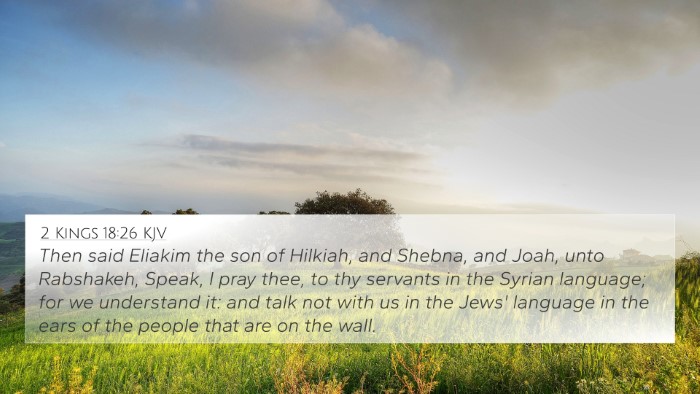
2 Kings 18:26 (KJV) »
Then said Eliakim the son of Hilkiah, and Shebna, and Joah, unto Rabshakeh, Speak, I pray thee, to thy servants in the Syrian language; for we understand it: and talk not with us in the Jews' language in the ears of the people that are on the wall.

Daniel 2:4 (KJV) »
Then spake the Chaldeans to the king in Syriack, O king, live for ever: tell thy servants the dream, and we will shew the interpretation.

Isaiah 36:11 (KJV) »
Then said Eliakim and Shebna and Joah unto Rabshakeh, Speak, I pray thee, unto thy servants in the Syrian language; for we understand it: and speak not to us in the Jews' language, in the ears of the people that are on the wall.

Ezra 4:17 (KJV) »
Then sent the king an answer unto Rehum the chancellor, and to Shimshai the scribe, and to the rest of their companions that dwell in Samaria, and unto the rest beyond the river, Peace, and at such a time.

Ezra 4:9 (KJV) »
Then wrote Rehum the chancellor, and Shimshai the scribe, and the rest of their companions; the Dinaites, the Apharsathchites, the Tarpelites, the Apharsites, the Archevites, the Babylonians, the Susanchites, the Dehavites, and the Elamites,
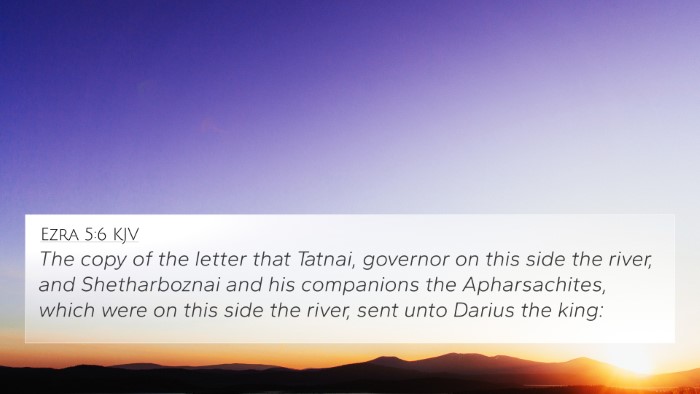
Ezra 5:6 (KJV) »
The copy of the letter that Tatnai, governor on this side the river, and Shetharboznai and his companions the Apharsachites, which were on this side the river, sent unto Darius the king:
Ezra 4:7 Verse Analysis and Similar Verses
Understanding Ezra 4:7
Ezra 4:7 presents a significant moment within the historical narrative of the return from Babylonian exile, specifically reflecting on the opposition faced by the Jews in rebuilding Jerusalem. The verse states: "And in the days of Artaxerxes, wrote Bishlam, Mithredath, Tabeel, and the rest of their companions unto Artaxerxes king of Persia; and the writing of the letter was written in the Syrian tongue, and interpreted in the Syrian tongue."
Meaning and Interpretation
This verse highlights several key elements:
- Political Opposition: The letter signifies the organized resistance against the rebuilding efforts in Jerusalem. Matthew Henry notes that the opposition was both formal and malicious, indicating the persistent challenges faced by those seeking to restore their homeland.
- Language and Communication: The use of the Syrian language in the letter illustrates the cultural and political dynamics of the time. Adam Clarke points out that the choice of language was strategic, catering to the linguistic context of the king.
- The Role of Authorities: The involvement of high-ranking officials (e.g., Bishlam and others) reflects the political intrigue and the importance of aligning with powerful figures in the Persian Empire, as noted by Albert Barnes. Their actions were meant to sway the king against the Jewish inhabitants.
Cross-Referencing Biblical Texts
Ezra 4:7 can be enriched by examining related scriptures that provide greater context and understanding. Below are Bible cross-references that highlight connections and thematic relations:
- Ezra 4:5: Discusses the efforts made to frustrate the builders by hiring counselors.
- Nehemiah 2:10: Nehemiah's news of the rebuilding efforts evokes similar antagonism from governors.
- Esther 3:8: Reflects the political scheming within the Persian Empire that affected Jewish people.
- Daniel 6:1-5: Shows how envious officials can conspire against the Jews.
- Isaiah 44:28: Prophecies regarding the rebuilding of Jerusalem, opposing the current events noted in Ezra.
- Zechariah 1:16: A prophetic encouragement for the returnees amidst discouragement.
- 1 Peters 5:8: A reminder of the adversary who seeks to disrupt God's work through opposition.
Thematic Connections
Several themes emerge through a comparative Bible verse analysis of Ezra 4:7:
- Resilience in Leadership: Other scriptures discuss the importance of leadership and resilience in the face of adversity, such as Nehemiah's steadfastness in Nehemiah 4:18.
- Divine Sovereignty: The overarching themes of God's sovereignty in both Isaiah 54:17 and Romans 8:31 assure believers of victory amidst opposition.
- Perseverance in Prayer: Foundational to the rebuilding efforts, seen in James 5:16 where prayer is positioned as crucial for overcoming struggles.
Conclusion
In conclusion, Ezra 4:7 is a poignant reminder of the difficulties faced by God's people as they endeavored to restore Jerusalem. The verse encapsulates the complexities of political maneuvering, language barriers, and community resilience. By utilizing tools for Bible cross-referencing, individuals can explore thematic Bible verse connections, deepening their understanding of Scripture and the historical context surrounding Ezra's narrative.
This verse invites further exploration of how Scriptures relate to one another, promoting a rich tapestry of inter-Biblical dialogue and cross-referenced themes that resonate today.
